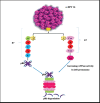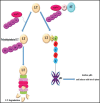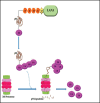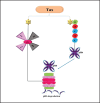Human Viral Oncoproteins and Ubiquitin-Proteasome System
- PMID: 39224462
- PMCID: PMC11368560
- DOI: 10.1055/s-0044-1790210
Human Viral Oncoproteins and Ubiquitin-Proteasome System
Abstract
Some human cancers worldwide may be related to human tumor viruses. Knowing, controlling, and managing the viruses that cause cancers remain a problem. Also, tumor viruses use ubiquitin-proteasome system (UPS) that can alter host cellular processes through UPS. Human tumor viruses cause persistent infections, due to their ability to infect their host cells without killing them. Tumor viruses such as Epstein-Barr virus, hepatitis C virus, hepatitis B virus, human papillomaviruses, human T cell leukemia virus, Kaposi's sarcoma-associated herpesvirus, and Merkel cell polyomavirus are associated with human malignancies. They interfere with the regulation of cell cycle and control of apoptosis, which are important for cellular functions. These viral oncoproteins bind directly or indirectly to the components of UPS, modifying cellular pathways and suppressor proteins like p53 and pRb. They can also cause progression of malignancy. In this review, we focused on how viral oncoproteins bind to the components of the UPS and how these interactions induce the degradation of cellular proteins for their survival.
Keywords: UPS; oncoprotein; proteasome; tumor virus; ubiquitin.
The Author(s). This is an open access article published by Thieme under the terms of the Creative Commons Attribution License, permitting unrestricted use, distribution, and reproduction so long as the original work is properly cited. ( https://creativecommons.org/licenses/by/4.0/ ).
Conflict of interest statement
Conflict of Interest None declared.
Figures









Similar articles
-
The Ubiquitin-Specific Protease Usp7, a Novel Merkel Cell Polyomavirus Large T-Antigen Interaction Partner, Modulates Viral DNA Replication.J Virol. 2020 Feb 14;94(5):e01638-19. doi: 10.1128/JVI.01638-19. Print 2020 Feb 14. J Virol. 2020. PMID: 31801860 Free PMC article.
-
The Role of DNA Viruses in Human Cancer.Cancer Inform. 2023 Jun 13;22:11769351231154186. doi: 10.1177/11769351231154186. eCollection 2023. Cancer Inform. 2023. PMID: 37363356 Free PMC article. Review.
-
Regulation of Autophagy in Cells Infected With Oncogenic Human Viruses and Its Impact on Cancer Development.Front Cell Dev Biol. 2020 Feb 28;8:47. doi: 10.3389/fcell.2020.00047. eCollection 2020. Front Cell Dev Biol. 2020. PMID: 32181249 Free PMC article. Review.
-
Metabolic Control by DNA Tumor Virus-Encoded Proteins.Pathogens. 2021 May 6;10(5):560. doi: 10.3390/pathogens10050560. Pathogens. 2021. PMID: 34066504 Free PMC article. Review.
-
HPV Oncoproteins and the Ubiquitin Proteasome System: A Signature of Malignancy?Pathogens. 2020 Feb 18;9(2):133. doi: 10.3390/pathogens9020133. Pathogens. 2020. PMID: 32085533 Free PMC article. Review.
Cited by
-
Mass Spectrometry-Based Proteomics Technologies to Define Endogenous Protein-Protein Interactions and Their Applications to Cancer and Viral Infectious Diseases.Mass Spectrom Rev. 2025 Feb 9:10.1002/mas.21926. doi: 10.1002/mas.21926. Online ahead of print. Mass Spectrom Rev. 2025. PMID: 39924651 Free PMC article. Review.
-
RNF5 inhibits HBV replication by mediating caspase-3-dependent degradation of core protein.Front Microbiol. 2025 Apr 1;16:1548061. doi: 10.3389/fmicb.2025.1548061. eCollection 2025. Front Microbiol. 2025. PMID: 40236486 Free PMC article.
References
-
- Thomas M, Banks L. Viral oncoproteins and ubiquitination: accessing a cellular toolbox for modifying protein function. FEBS J. 2017;284(19):3168–3170. - PubMed
-
- L Aravind EVK . The U box is a modified RING finger - a common domain in ubiquitination. Curr Biol. 2000;10(04):132–134. - PubMed
-
- Jackson P K, Eldridge A G, Freed E et al.The lore of the RINGs: substrate recognition and catalysis by ubiquitin ligases. Trends Cell Biol. 2000;10(10):429–439. - PubMed
Publication types
LinkOut - more resources
Full Text Sources
Research Materials
Miscellaneous

